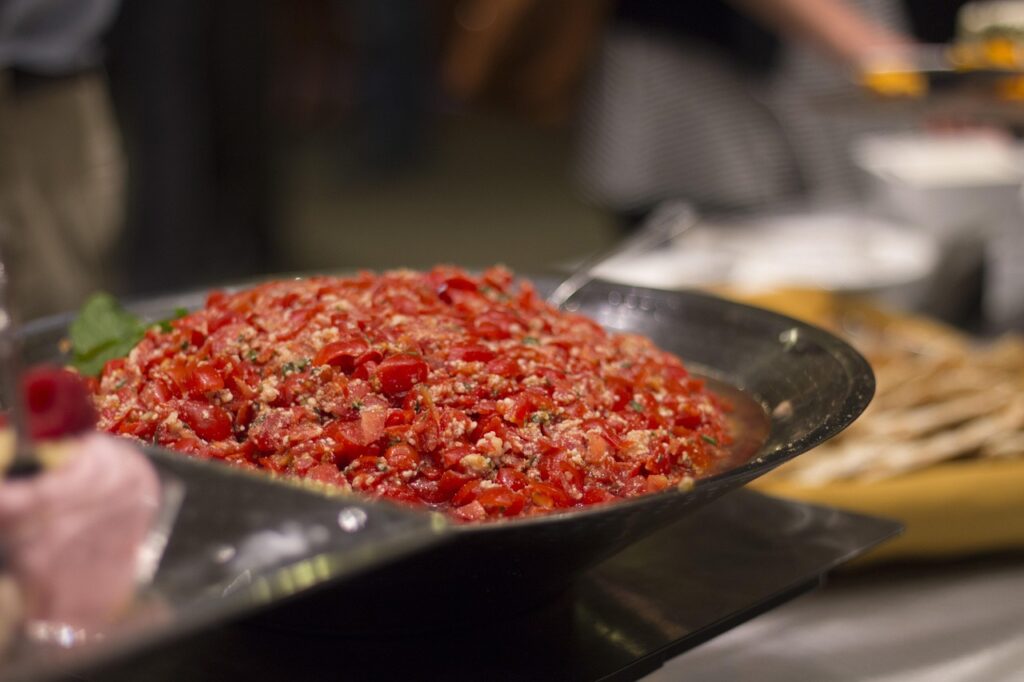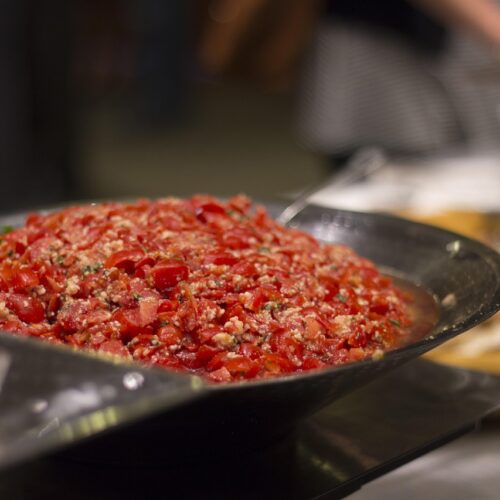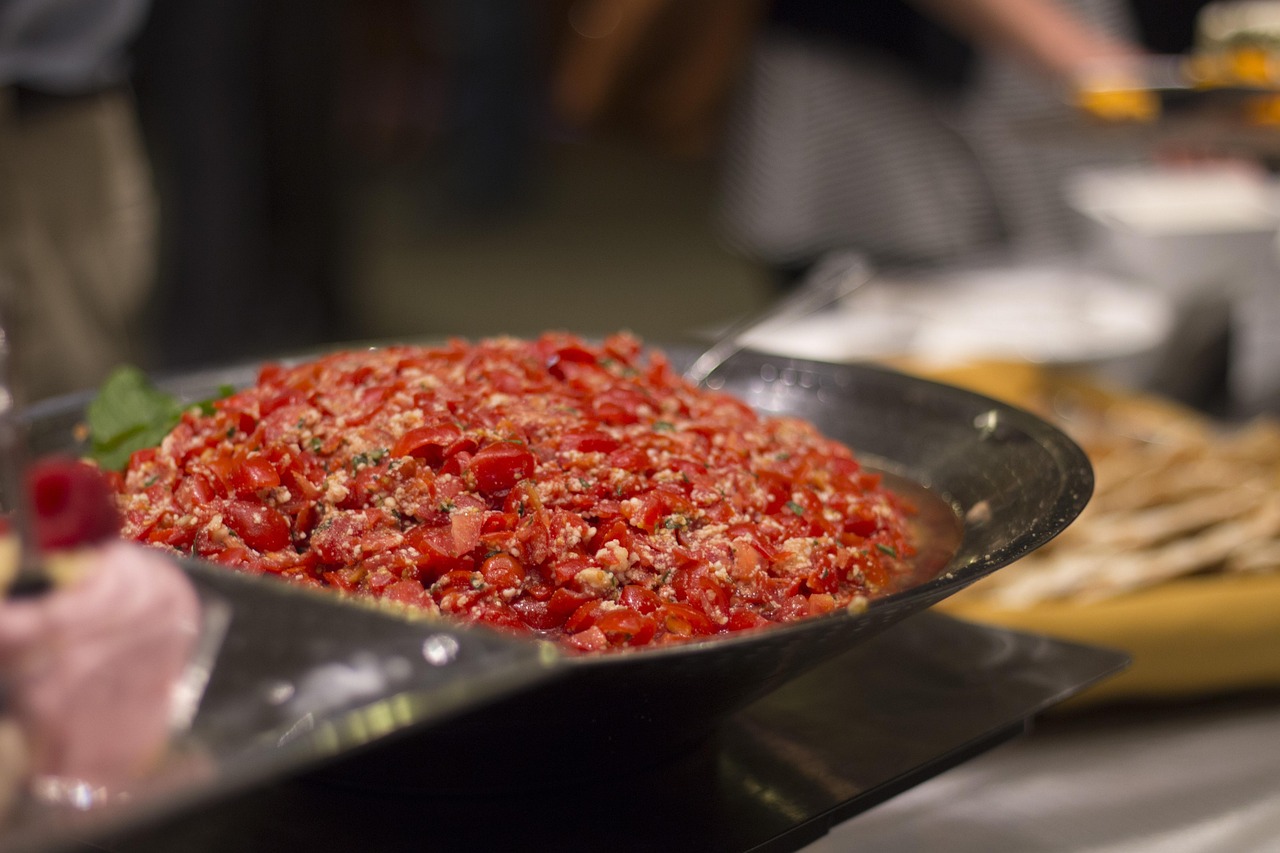The main ingredients of salsa, a tasty and frequently spicy sauce or dip, are tomatoes, chili peppers, onions, and herbs. Salsa, which has Mexican origins, is frequently used as a condiment or side dish to improve the flavor of a variety of dishes.

Ratings 05

What Is The Salsa
01. Key Features Of Salsa
- Main Ingredients: Tomatoes, onions, chili peppers, garlic, cilantro, lime juice.
- Texture: Can range from chunky (pico de gallo) to smooth (blended salsas).
- Flavor Profile: Fresh, tangy, spicy, and aromatic.
Types
- Salsa Roja: Red salsa made with ripe tomatoes.
- Salsa Verde: Green salsa made with tomatillos.
- Pico de Gallo: Fresh, uncooked chunky salsa.
- Fruit Salsa: Made with ingredients like mango, pineapple, or peach.
02. Common Uses
- Dip for tortilla chips
- Topping for tacos, nachos, burritos, and quesadillas
- Accompaniment to grilled meats and fish
- Flavor boost for eggs, rice, and salads
Health Benefits Of Salsa
Here are the health benefits of salsa, especially when it’s homemade with fresh, natural ingredients:
01. Low In calories
Salsa is a fantastic choice for people watching their weight because it is naturally low in fat and calories.
02. Packed With Antioxidants And Vitamins
- Vitamin C, potassium, and lycopene, an antioxidant associated with heart health and cancer prevention, are all abundant in tomatoes.
- Allicin and other immune-boosting and anti-inflammatory compounds can be found in onions and garlic.
03. Encourages The Metabolism
Capsaicin, which is found in chili peppers like jalapeños, has the ability to slightly boost metabolism and promote fat burning.
04. Aids In Digestion
Onions and lime juice are two ingredients that can help improve gut health and stimulate digestive enzymes.
05. Encourages Heart Health
In addition to being low in cholesterol and saturated fats, fresh salsa is high in potassium, fiber, and heart-healthy antioxidants.
06. Refreshing And Hydrating
Due to their high water content, lime juice and tomatoes can help you stay hydrated.
07. Naturally Low In Sugar (When Homemade)
Unlike some commercial sauces, homemade salsa typically contains no added sugar or preservatives.
To maximize health benefits, avoid store-bought versions with excess sodium or additives—opt for fresh, homemade salsa!
Tips For Making Salsa
Here are some useful tips for making salsa that’s fresh, flavorful, and perfectly balanced:
01. Use Fresh, Ripe Ingredients
- Fresh tomatoes, onions, garlic, cilantro, and lime juice make a big difference in taste.
- If tomatoes aren’t in season, canned fire-roasted tomatoes are a good alternative.
02. Chop Ingredients Evenly
- For chunkier salsa (like pico de gallo), dice ingredients into uniform pieces for even texture and flavor in every bite.
03. Season Gradually
- Start with a little salt and lime juice. Let it sit, then taste and adjust. Flavors will intensify as they blend.
04. Control The Heat
- Chili peppers can be made less spicy by removing the seeds and membranes.
- Add peppers gradually if you’re unsure of the heat level.
05. Let It Rest
- Enable the salsa to cool for at least half an hour before serving. This involves just letting the flavor mixture be more stressful.
06. Blend Or Keep It Chunky
- For smooth salsa, blend all ingredients in a food processor.
- For a rustic texture, chop everything by hand.
07. Store Properly
- Keep salsa refrigerated in an airtight container. It typically lasts three to five days.
08. Get Creative
- Try variations like mango, pineapple, roasted tomato, avocado, or corn salsa for new flavor profiles.
FAQ Salsa
Here’s a list of Frequently Asked Questions (FAQ) about Salsa to help you better understand and enjoy this delicious condiment:
01. What Is Salsa Made Of?
Salsa typically includes tomatoes, onions, chili peppers, garlic, lime juice, and cilantro. Variations may add fruits, corn, or tomatillos.
02. Is Salsa Healthy?
Likewise! Salsa is full of food as well as low in calories. Antioxidants have new Homemade versions healthier than store-bought ones.
03. How Long Does Homemade Salsa Last?
For up to three or five days, maintain the homemade salsa container in the fridge. Always look for signs of spoilage, such as mold in the cavity.
04. Can I Freeze Salsa?
Yes, but only cooked or blended salsa freezes well. Chunky, fresh salsas like pico de gallo may lose texture after freezing.
05. How Do I Make Salsa Less Spicy?
- Use fewer chili peppers.
- Remove the seeds and membranes.
- Add additional tomatoes, a little sugar, or lime juice to balance the heat.
06. What’s The Difference Between Salsa And Pico De Gallo?
Pico de gallo is a fresh, chunky salsa made with raw diced ingredients. Regular salsa can be blended or cooked and is usually saucier.
07. Can I Use Canned Tomatoes For Salsa?
Yes! Canned fire-roasted tomatoes are a great option, especially when fresh tomatoes aren’t in season.
08. What Foods Go Well With Salsa?
Tortilla chips, tacos, burritos, grilled meats, eggs, rice bowls, nachos, and more!

Salsa
Ingredients
- 4 ripe tomatoes (or 1 can of diced tomatoes, drained)
- 1 small onion, finely chopped
- 1–2 fresh jalapeño peppers, seeded and minced (adjust for spice)
- 2 cloves garlic, minced
- 1/2 cup fresh cilantro leaves, chopped
- Juice of 1 lime
- Salt to taste
- Optional: 1/2 teaspoon ground cumin or a pinch of sugar
Instructions
- Prepare the vegetables: If using fresh tomatoes, dice them finely. Finely chop the onion, jalapeños, garlic, and cilantro.
- Mix ingredients: In a mixing bowl, combine the tomatoes, onion, jalapeños, garlic, and cilantro.
- Add flavor: Squeeze in the lime juice, and season with salt (and cumin or sugar if using). Stir well to combine.
- Adjust to taste: Taste and adjust the seasoning as needed — more lime juice, salt, or spice.
- Chill (optional): For best flavor, cover and refrigerate for 30 minutes before serving.
- Serve: Enjoy with tortilla chips, tacos, grilled meats, or as a topping for your favorite dishes!
-
Salsa
The main ingredients of salsa, a tasty and frequently spicy sauce or dip, are tomatoes, chili peppers, onions, and herbs. Salsa, which has Mexican origins, is frequently used as a condiment or side dish to improve the flavor of a variety of dishes. Ratings 05 What Is The Salsa 01. Key Features Of Salsa Types…


Leave a Comment